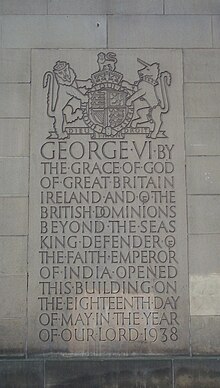King-Emperor
This article needs additional citations for verification. (November 2016) |

The 'R' and 'I' after his name indicate 'king' and 'emperor' in Latin ('Rex' and 'Imperator').
A king-emperor, the female equivalent being queen-empress, is a sovereign ruler who is simultaneously a king of one territory and emperor of another. This title usually results from a merger of a royal and imperial crown, but recognises that the two territories are different politically or culturally and in status (emperor being a higher rank than king). It also denotes a king's imperial status through the acquisition of an empire or vice versa.
The dual title signifies a sovereign's dual role, but may also be created to improve a ruler's prestige. Both cases, however, show that the merging of rule was not simply a case of annexation where one state is swallowed by another, but rather of unification and almost equal status, though in the case of the British monarchy the suggestion that an emperor is higher in rank than a king was avoided by creating the title "king-emperor" ("queen-empress") instead of "emperor-king" ("empress-queen").
In the British Empire[]


The British Crown had officially taken over the governing of British India from the East India Company in 1858, in the aftermath of what the British called 'the Indian Mutiny'. Henceforth, the new British Raj was ruled directly from Whitehall via the India Office. Following the Delhi Durbar in 1877, Queen Victoria was given Imperial status by the British Government, and she assumed the title Empress of India. She was thus the Queen-Empress, and her successors, until George VI, were known as King-Emperors. This title was the shortened form of the full title, and in widespread popular use.
The reigning King-Emperors or Queen-Empress used the initials R I (Rex Imperator or Regina Imperatrix) or the abbreviation Ind. Imp. (Indiae Imperator/Imperatrix) after their name (while the one reigning Queen-Empress, Victoria, used the initials R I, the three consorts of the married King-Emperors simply used R).
British coins, and those of the British Empire and Commonwealth dominions, routinely included some variation of the titles Rex Ind. Imp., although in India itself the coins said "Empress", and later "King Emperor." When, in August 1947, India became independent, all dies had to be changed to remove the latter two abbreviations, in some cases taking up to a year. In the United Kingdom, coins of George VI carried the title up to 1948.
In Austria-Hungary[]
Another use of this dual title was when, in 1867, the multi-national Austrian Empire, which was German-ruled and facing growing nationalism, undertook a reform that gave nominal and factual rights to Hungarian nobility. This reform revived the Austrian-annexed Kingdom of Hungary, and therefore created the dual-monarchic union state of Austria-Hungary and the dual title of "emperor-king" (in German Kaiser und König, in Hungarian Császár és Király).
The Habsburg dynasty therefore ruled as Emperors of Austria over the western and northern half of the Empire (Cisleithania), and as Kings of Hungary over the Kingdom of Hungary and much of Transleithania. Hungary enjoyed some degree of self-government and representation in joint affairs (principally foreign relations and defence). The federation bore the full name of "The Kingdoms and Lands Represented in the Imperial Council and the Lands of the Crown of St. Stephen".
In the Italian colonial empire[]
In 1936, with the Italian conquest of Ethiopia, Victor Emmanuel III was proclaimed Emperor of Ethiopia. Thus he became King-Emperor (in Italian Re Imperatore), i.e., King of Italy and Emperor of Ethiopia, because conquered Ethiopia was then an Empire. In the following years foreign countries recognized the Italian rule in Ethiopia (UK in 1937).
The King-Emperor was represented by the Viceroy, who was also appointed as Governor-General of Italian East Africa (AOI - Africa Orientale Italiana). The capital city of the Viceroy and Governor-General was Addis Ababa.
Titles[]
- The Serbian emperor Stefan Dušan (r. 1346–55), earlier king (1331–45), is attested with the title "Emperor of Greece and King of All Serb Lands and the Maritime" in a document dating to between 1347–56 (see also Emperor of the Serbs).[1] Dušan has been described as a "king-emperor".[2]
- The German Empire was also ruled by an Emperor-King, as the German Hohenzollern Emperor was also King of Prussia.
- The Holy Roman Emperors were also Kings of Italy, Bohemia, Germany and Burgundy for most of the time that title existed.
- Emperor Napoléon I of the French was also King of Italy. His title was shortened in "Emperor-King" (Empereur-Roi or l'Empereur et Roi) rather than "King-Emperor".
- John VI of Portugal was made titular Emperor of Brazil alongside being King of Portugal and was titled as King-Emperor until his death. After John VI's death, his son Pedro briefly acceded him as King of Portugal while reigning as Emperor of Brazil.
See also[]
References[]
- ^ Miklosich, Franz (1858). Monumenta serbica spectantia historiam Serbiae, Bosnae, Ragusii ed: Fr. apud Guilelmum Braumüller. p. 154.
- ^ James Evans (30 July 2008). Great Britain and the Creation of Yugoslavia: Negotiating Balkan Nationality and Identity. I.B.Tauris. p. 81. ISBN 978-0-85771-307-0.
- Kings
- Emperors
- Royal titles
- Imperial titles
